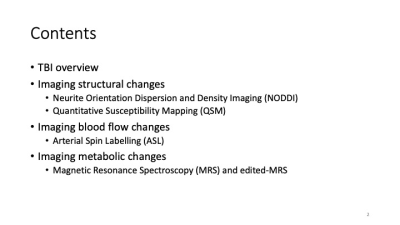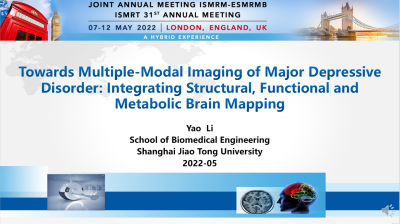Weekend Course
Imaging Brain Injury, Pain & Recovery
Joint Annual Meeting ISMRM-ESMRMB & ISMRT 31st Annual Meeting • 07-12 May 2022 • London, UK

| Traumatic Brain Injury | |||
| 12:30 |  |
Advances in Imaging of Traumatic Brain Injury
Tiffany Bell
Traumatic brain injury, caused by an external blow to the head, is a major cause of disability worldwide. Brain imaging is crucial to understanding the pathophysiology behind mild traumatic brain injury. This lecture will present several examples of promising advancements in brain imaging, including imaging brain structure, blood flow and brain metabolites, that provide more extensive understanding of the effects of mild traumatic brain injury.
|
|
| 12:55 | Imaging Recovery from Severe Traumatic Brain Injury
Brian Edlow
Multiple studies from laboratories around the world have now shown that 15-20% of patients with severe traumatic brain injury (TBI) who appear unresponsive on the bedside behavioral examination are "covertly consciousness", as evidenced by volitional modulation of brain activity on task-based functional MRI or EEG. In this talk, we will discuss emerging insights into covert consciousness that are shedding new light into mechanisms of recovery from severe TBI. We will focus on recently published guidelines that recommend the clinical implementation of these advanced techniques to improve the standard of care for patients with severe TBI.
|
||
| Stroke | |||
| 13:20 | Advances in Stroke Imaging
Peiying Liu
Recent studies have demonstrated the role of advanced MRI in the patient selection and management of acute stroke. It has also been demonstrated that using MRI as the first-line imaging technique can be fast, suitable, and useful to improve recanalization rates and patient outcomes. This presentation will review recent advances of the standard clinical MRI sequences including structural MRI, susceptibility weighted imaging (SWI), MR angiography (MRA), diffusion-weighted imaging (DWI) and perfusion-weighted imaging (PWI), as well as new techniques such as MR Fingerprinting (MRF), Amide proton transfer (APT) MRI, intravoxel incoherent motion (IVIM) MRI, and Quantitative susceptibility mapping (QSM).
|
||
| 13:45 | Predicting Functional Recovery After Stroke Using Advanced MRI
Ranliang Hu
|
||
| 14:10 | Break & Meet the Teachers |
||
| Pain | |||
| 14:35 | How neuroimaging of pain pathways can decode chronic pain
Javeria Hashmi
Towards understanding the role of the brain in chronic pain aetiology, we investigate how threat predictions modulate pain perception through PAG circuitry. The central nervous system has an inbuilt capacity to modify pain intensity adaptively in relation to perceived threat (3). Processes in the brain that integrate noxious inputs with top-down threat signals play a key role in pain perception. These systems also have the capacity to bias the experience of pain away from the sensory evidence and towards expectations and beliefs. This talk discusses neurobiological pathways and mechanisms that are affected in chronic pain.
|
||
| 15:00 | Pain modulation: perception and neural correlates
Susanne Becker
How we perceive pain varies strongly –not only between people, but also within a person. While peripheral and biological factors cause some of this variation, a large amount of this variation is mediated by central and psychological processes. One impressive example is placebo analgesia, with strong pain inhibition induced by expectations and learning. Psychological pain modulation is not just a response bias or an artefact. Corresponding changes in brain activation and functional networks have been found and often replicated. I will give an overview of brain mechanisms underlying the modulation of perceived pain and examine their assessment and application critically.
|
||
| Depression | |||
| 15:25 | Imaging the Neural Correlates of Social Pain
Yazhuo Kong
|
||
| 15:50 |  |
Towards Multiple-Modal Imaging of Major Depressive Disorder: Integrating Structural, Functional & Metabolic Brain Mapping
Yao Li
Major depressive disorder (MDD) is a neuropsychiatric condition with high lifetime prevalence and suicide attempt rate. Developing useful biomarkers with diagnostic and prognostic value is of great importance for a better understanding of the pathophysiology as well as the treatment guidance of MDD. This lecture will briefly review the progresses in MR-based structural (MRI, Diffusion MRI), functional (BOLD-fMRI, ASL-fMRI), and metabolic imaging (MRS, MRSI) of the brain, which have provided significant insights into the pathophysiology of MDD in clinical settings.
|
|
The International Society for Magnetic Resonance in Medicine is accredited by the Accreditation Council for Continuing Medical Education to provide continuing medical education for physicians.